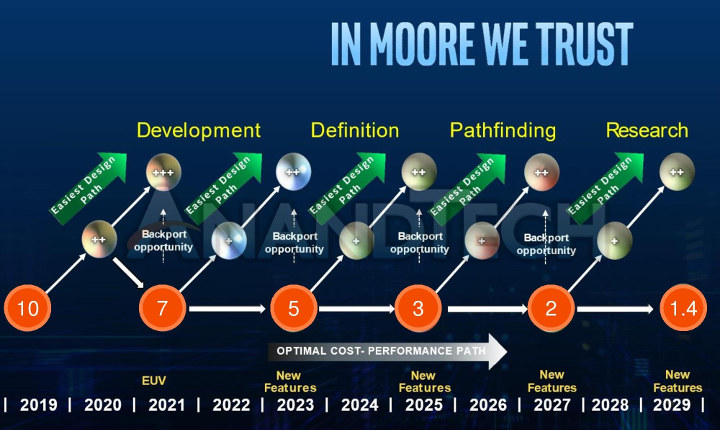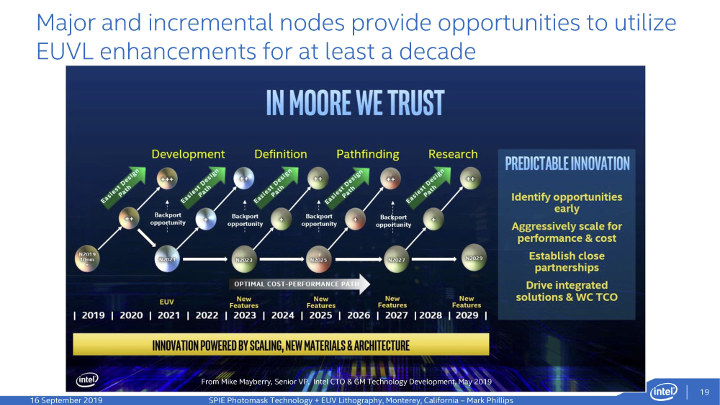A roadmap from a slide by ASML presented at the IEDM conference recently shared on Anandtech shows Intel Roadmap for the next ten years with 7nm manufacturing process expected in 2021, 5nm in 2023, 3nm in 2025, 2nm in 2027, and 1.4nm in 2029.

Intel did however contact Anandtech to explain the slide from ASML is a modified version of the Intel slide shown below that does not show actual process nodes, only the dates. I suppose Intel does not want to make any commitments seeing how their 10nm technology suffered delays after delays, and in any case the actual dimensions of the process may vary by that time frame depending on difficulties or new discoveries made.

Both slides mention +, ++, and backport opportunities for all new processes. + and ++ are just iterative improvements for the current process, while back- porting is the option to port a process developed on the latest node to the previous ++ process node (e.g. a 5nm processor, may end up being a 7nm++ processor) possibly for cost-reasons or delays in the new process. The 10nm will apparently have 3 iterative improvements since the slide shows both 10nm++ and 10nm+++ are planned.
The 2nm and 1.4nm process technologies are still at the research stage, so we’ll have to see whether researchers can solve challenges brought about by such tiny process nodes.

Jean-Luc started CNX Software in 2010 as a part-time endeavor, before quitting his job as a software engineering manager, and starting to write daily news, and reviews full time later in 2011.
Support CNX Software! Donate via cryptocurrencies, become a Patron on Patreon, or purchase goods on Amazon or Aliexpress. We also use affiliate links in articles to earn commissions if you make a purchase after clicking on those links.




And why should we trust Intel after the 10nm debacle?
Do you have a billion dollar fab contract with them that’ll make you go bust if it doesn’t happen? If not why do you need to trust them?
Developers that trusted Intel the last few years and targeted their new instructions instead of pursuing concurrency and parallelism opportunities ended up losing cycles over speculative mitigations and heat throttling. In conjunction with Nvidia’s pricing policy, many HPC and gaming projects were delayed by years or even indefinitely put on hold.
I’m not sure why anyone would trust marketing. Everyone knows that the vast majority of marketing is complete bullshit. If you can’t buy it and test it yourself then it doesn’t exist or isn’t as good as they say.
If these *developers* trusted a company without a contract then they’ve been fools.
From what I gather some companies have actually been burned by having contracts with Intel for their 10nm fab process that hasn’t materialised as promised. I think having an actual contract with Intel gives them some right to feel wronged and I hope they sue Intel.
This is going to be fun. In a ’10GHz by 2005′ kind of way (https://www.anandtech.com/show/680/6)
Recent internal meeting at Intel:
Intel Marketing: AMD just landed on Mars! We are going to announce we will land on the Sun next year.
Intel Engineering: Impossible. We’ll be fried and destroyed way before reaching the surface.
Intel Marketing: We really have to explain you everything. We’ll land by night.
“In Moore we trust” !!!! 😛 🙂